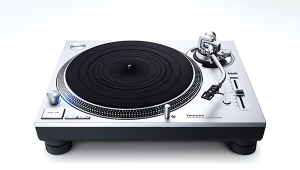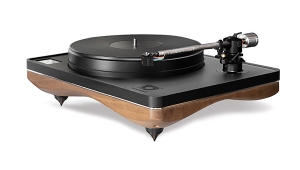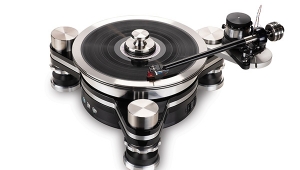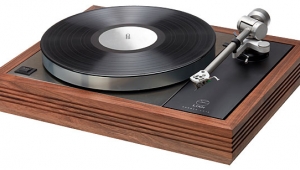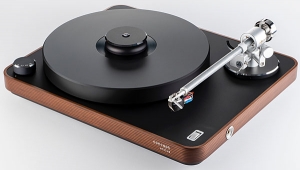| Columns Retired Columns & Blogs |
Oracle Delphi turntable TJN & Delphi Mk.IV
Thomas J. Norton wrote about the Delphi Mk.IV in August 1991 (Vol.14 No.8):
Footnote 1: I ignore here the cassette corps, which was last seen milling about somewhere in another county.
"What am I going to use for a lead?" I wondered, seated in the dentist's chair, a lead apron squashing my vitals. I was doing my best to forget where I was—and what that implied for the immediate future—by mulling over the review I was about to commit to floppy disc.
"Smile," I could swear I heard the dentist say. Easy for him—he wasn't biting down on a medieval oral torture device. The X-ray machine buzzed, the dentist emerged from behind his 3'-thick lead- and concrete-reinforced bunker to survey the damage, removed the apron from my lap and the bit from my mouth, then disappeared again, presumably to a developing room.
When he reappeared, he was wielding a syringe which convinced me he did dental work on elephants in his spare time.
"Novocaine?" he asked. Following my positive, if less than enthusiastic response, he proceeded to perform acts which some analog LP fans have been known to prefer to listening to CDs.
"That's it!" I cried, fortunately catching the startled dentist between stabs. "CDs and root-canal work. What a concept!" The good doctor, undoubtedly thinking that I was making some sort of deranged reference to a new way to pay for the current costs of oral surgery, went on about his prickly business. But I was off on a tangent of mental composition, my awareness of my surroundings numbing at about the same rate as my lower jaw...
Despite the fact that everyone "knows" that LPs are dead, killed off by "perfect sound forever," audiophiles are split into several camps, an uneasy truce existing between them. Firmly established in the center of the valley is the digital division. This group, already huge in number, grows stronger by the week, encouraged in their efforts by hardware and software manufacturers who, in turn, are bolstered by increasing sales of digital everything—a vast, self-fulfilling cycle of ever-increasing supply and demand (footnote 1). Just over the hill is the "analog forever" brigade. No CDs or CD players are allowed into their midst. Concluding back in 1983 that CD was the work of some evil empire, they determined then and forever that the dreaded digits would never enter their domain. They are rapidly running short of ammunition, but are still in high spirits, buoyed by the huge supply of used records discarded by the less enlightened.
Scattered about are smaller, factional encampments which take neither extreme position, but which disagree among themselves on whether to lean toward analog or digital as a primary source. Members of this group usually have good-sized collections of vinyl which they intend to keep and continue to play and enjoy, while accepting digital—either reluctantly or happily—as a fact of life. Many, if pressed, admit to a preference, marginal or substantial, for the sound of analog. They wish that the record companies continued to give them a choice in the matter, but realize that the choice is no longer there. They add to their analog collections slowly (mainly with used LPs) or not at all. They buy CDs because that is the only way to acquire new recordings. And, for the most part, they note that CDs and CD playback equipment are improving dramatically—if sometimes at a price. Still, they are looking for ways to improve their enjoyment of their existing analog collections and of any LPs they are able to add to it. The LP market is no longer a mass one, but it is still a far from an insignificant one when the market in used vinyl is added into the mix. Turntable manufacturers may not be able to count on ever-increasing sales, but most of the major names are not only hanging in there, but continuing to upgrade their products.
When Oracle produced their first turntable back in the dim mists of 1979, when analog LP was clearly still king, it was a solid success, combining technical innovation, top-quality construction, and dazzling styling. Today the Oracle line has expanded to include a number of different models. The top two—the Premier Mk.IV and the Delphi Mk.IV—retain the styling of the original, which continues to look futuristic even as the status of analog in the 21st century looks increasingly tentative.
Description
To begin with, the Delphi Mk.IV—the Oracle du jour here—is a belt-driven, suspended-subchassis design. Nothing particularly new there, but, as in most things, the story is in the execution. The open design of the Delphi, which gives it its striking good looks, was apparently a deliberate design choice. Eliminating the conventional cabinet which surrounds virtually all other turntables (with a few notable exceptions) eliminates any chance of cabinet resonances being excited by airborne vibrations and of those resonances being passed on to the system's moving parts. While this is not likely to be a serious problem if the suspension design is well executed, what is possible is transmission of vibrations to the system's suspended parts—the subchassis, platter, arm, and cartridge. Oracle keeps the size of these to a minimum by reducing the dimensions of the subchassis to the barest essentials—just what is needed to hold the tonearm, the bearing assembly on which the platter rests, a built-in bubble-level, and the support arms which rest on the three suspension towers. The subchassis itself is a four-ply laminate.
New to the Mk.IV is a 3 lb counterweight on the subchassis opposite the tonearm, which improves the overall stability of the suspended system. The use of such a counterweight was, to my knowledge, first proposed by Brooks Berdan several years ago and incorporated in his mods for earlier Oracles (footnote 2).
The Delphi Mk.IV's platter is a laminate of a composite material sandwiched between layers of aluminum. This platter is also new to the Mk.IV (previous versions were all-aluminum). Its mass is concentrated at the perimeter to increase momentum and minimize the effect of outside disturbances, including the increase in stylus drag which is known to occur with heavy groove modulations. Atop this platter is a hard polymer mat—a significant change in the Mk.IV from Oracle's older soft, sticky mat. This new "mat" is actually an integral part of the laminated platter, machined in-place to its finished form and not merely stuck on in final assembly.
Also incorporated into the platter is Oracle's record-coupling system. The top of the spindle is threaded and a threaded clamp is provided which secures the record tightly to the platter—assisted by a slight upward dishing of the latter at its outer edge. A tapered washer is provided which may be used over the spindle under the record; in conjunction with the clamp, this helps force the record down against the platter. While this clamping system is less effective than a vacuum platter, it is also less complicated to implement. Perhaps that's why it's been used in various guises by a number of other turntable manufacturers. To the best of my knowledge, Oracle was the first to use it. With their new, dished mat, Oracle feels that the under-disc washer is not really necessary. I found that without the washer the degree to which the clamp was tightened was much more critical. Tighten it too much and the outside of the record would rise and lose contact with the disc. With the washer, this was far less likely.
The tonearm is mounted on a cantilevered outrigger of the subchassis. The mounting plate—which can be precut by Oracle for any tonearm (and I recommend letting them do so unless you're skilled at machining aluminum)—is a two-piece clamshell affair which fits over the top and bottom of a large ring forming the outer portion of the cantilever. (Brooks Berdan, incidentally, recommends a small amount of damping—such as Mortite—at the junctions of the mounting-plate pieces and the subchassis—a mod I did not have the opportunity to try.) This arrangement afforded me no trouble when mounting either the Oracle SME 345 tonearm or the SME V.
But mounting the Graham tonearm was another matter. The Oracle mounting plate is designed so that the arm is first mounted on its top half; then the latter, arm in place, is fastened to the subchassis by running bolts through the top piece of the mounting plate, through the opening of the cantilever "ring," and into tapped holes in the bottom half of the mounting plate, thus clamping the assembly firmly to the subchassis. But the base of the Graham tonearm obscures one of the holes in the top of the mounting plate required for this operation. You can't mount the Graham tonearm to the mounting plate before you fasten the plate to the subchassis because one of the three bolts clamping the top of the plate to the bottom will then be unusable. And you can't mount the Graham after fastening both mounting-plate halves to the subchassis because you can't then gain access to the underside of the top half of the mounting plate to fasten the nuts to the screws holding the Graham in place.
Footnote 1: I ignore here the cassette corps, which was last seen milling about somewhere in another county.
Footnote 2: A number of other Brooks Berdan ideas also appear in the most recent Oracles. Brooks has been working extensively on tweaking and modding Oracles (and, to a lesser extent, other turntables) for a number of years, first at GNP, an audio retail outlet in Pasadena, CA, and most recently in his own shop, Brooks Berdan Ltd., in Monrovia, CA. Brooks probably knows more about Oracles, and how to modify and get the most out of their earlier (and later) models, than anyone other than Oracle's own designers.
- Log in or register to post comments
